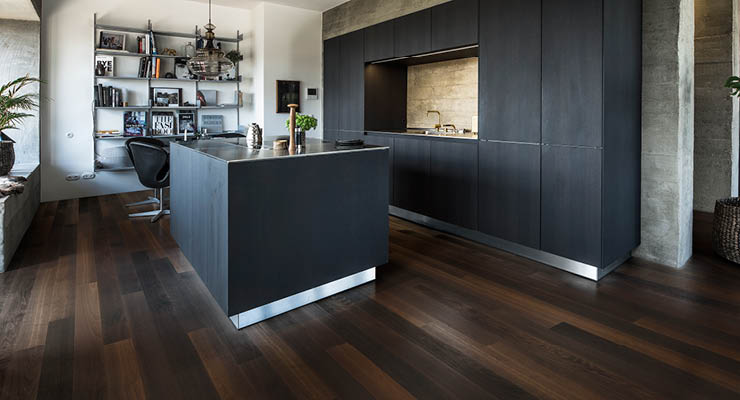The benefits of veneer-wood flooring
Veneer-wood floors are strong and durable. They also withstand seasonal humidity changes in your home. Veneer is an affordable alternative that combines a thinner layer of hardwood with HDF, making it a good environmental choice. Find out more about veneer flooring here.
Veneer-wood flooring – a beautiful and affordable choice
The main difference between lamella and veneer-wood floors is the surface layer’s thickness. The surface layer of a veneer-wood floor is usually around 1 millimetre thick, while a lamella floor is thicker.
A veneer-wood floor usually has two or three layers. All Kährs veneer floors have three layers: a surface layer, a framework and a backside. The surface layer is available in many different woods, colour variations and surface treatments. The framework consists of HDF (High Density Fibreboard) – a board made of compressed wood fibres. It is very durable and suits floors that need to withstand daily wear. Under the HDF framework is a piece of veneer backing. Using heat and pressure, we glue the components together into a durable construction. All the layers have a combined thickness of 7 millimetres. You can lay veneer-wood floors floating or glue them down.

The benefits of a veneer-wood floor
Stability
Our veneer-wood floors have a multi-layer construction to reduce the floor's natural movement. Since wood is a hygroscopic, or "living" material, seasonal humidity changes affect the wood. If you have a traditional solid-wood floor, your floor might swell or shrink, causing gaps between the boards. Veneer-wood floors have a cross-plied construction that counteracts movement, which makes the floor more stable.
Affordable and durable
As veneer-wood floors are cheaper to produce than lamella or solid-wood floors. This makes them affordable whilst still having an exclusive look. They are available in many colours and with different surface treatments.
Since surface treatments often harden floors, they are resistant to scratches and marks. This makes them suitable for spaces that are subject to wear, like children's bedrooms. You can’t sand veneer floors like you can lamella parquet, as sanding usually removes about 1 millimetre of the surface layer.
Minor refurbishments
Since veneer-wood floors are thinner than many other wood floors, they are well suited for minor refurbishments. You can often lay these types of floors on top of an old one if they are level and stable. Read more on how to lay veneer-wood flooring here.
Sustainable
Besides having a stable construction, veneer-wood floors are a good choice for the environment. They use less precious hardwood and use the material in a more effective way.
Veneer-wood flooring from Kährs
Below is a selection of the veneer-wood floors we manufacture at Kährs. You can see all our wood floors in our floor guide.


